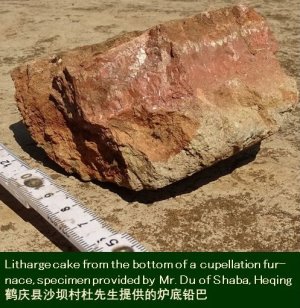Lead 铅,黑铅
Lead is the fifth of the ancient metals. Not too much use in itself, early metallurgists found out about it because it has a low melting point, is fairly abundant, and not uncommonly found together with copper ores. It can be added to bronze to ease casting where brittleness is not an issue. With the development of silver exploitation, it became important as a means to separate silver (and gold) in cupellation.
Silver (and gold) separation needed large amounts of metallic lead and produced small amounts of silver and large amounts of lead oxide. Lead pollution in smelting and cupellation was massive. The peaks of global lead pollution were caused mainly by the mines of classic Greece and Rome, medieval Song and of course our industrial age left their traces in raised lead levels in arctic ice cores.
Lead is toxic. Inhaling dust and ingesting lead, such as drinking or eating from lead utensils, all affect nerves and organs. However, these effects may not make themselves felt for many years. Lead accumulates in the body and will eventually lead to serious impairment. It gravely harms young children, who absorb the metal much more efficiently than adults and suffer impairments in body and brain development.
Besides pollution, large-scale silver mining means the production of massive amounts of lead. People soon found its uses for litharge. Thus the development of glazed pottery in classic Greece was stimulated by the availability of lead oxide. Lead oxide served as a flux that lowers the melting point of the main glaze component, usually ground sand (silica).
The topic is not thoroughly explored for China. It may not be a coincidence that the expansion of silver exploitation in the Tang period coincided with the popularity of three-coloured wares (sancai 三彩), which employed lead-glaze. Besides, the use of lead oxide as a medical substance called mituoseng 密陀僧 apparently intensified in the Tang-Song period as well. Explorations of lead glazes in the Southwest when silver mining shifted to this region from about the 14th century, are not available. It is evident from lead-rich dumps, however, that the costs of transport out of this mountainous inland region largely prevented commercial uses of lead.
History
Unsurprisingly, lead first appears in the same records in conjunction with silver, with specific mention for the Dingshan 町山 in the southeast of Lügao 律高, presumably in southern central Yunnan and for the Yangshan 羊山 in the west of Fengu 蕡古, presumably Gejiu 个旧 (Hanshu, see Yang Shouchuan 2014, 31).
Following these early records, the written sources fall silent until the later Ming. By this time, the terminology had become complicated by the new metal zinc, which had become known as qian 铅,woqian 倭铅 or baiqian 白铅. Lead could still be qian 铅 or be differentiated as heiqian 黑铅. While the binomials are clearly differentiated, the single character qian 铅 had become ambiguous. The identification is not helped by the fact that many deposits were in fact lead-zinc deposits and worked for both metals. In regional Qing terminology, the two metals were in fact differentiated, with lead now called lian 鐮, while qian 鉛 commonly refers to zinc. Pronunciation is lian and qian, respectively, in standard Chinese, but was very close in the regional dialect (both much like yuan).
Tiangong kaiwu 天工开物 contains the first description of lead smelting, and Diannan kuangchan tulue 滇南礦產圖略 provides some more specific information on lead ores and metallurgical processes in the context of silver mining. Three names of lead mines appear in the Qing records, but examinations so far suggest that these were sites primarily worked for silver and registered under the base metal.
The expansion of silver mining produced enormous amounts of lead. The final step of silver separation left mainly relatively pure litharge (lead oxide). As lead was a cheap metal, this product was not worth marketing at more remote sites, but simply dumped. Where markets were closer, litharge could be marketed, both as a drug (mituoseng 密陀僧) and as a component in pottery glaze. It could also be reduced to metal lead in another smelting, and in this shape became relatively widely used for making lead foil as a cheaper alternative to tin foil. As money for the nether world, tin, tin-lead, and lead foil was burnt at grave visits in large quantities. It should be added that the dumps of litharge and lead slags soon became resources that were re-exploited by local inhabitants. The large dumps gave rise to companies that started off as re-exploitation plants, such as the Burma Mining Company at the Bawdwin Mines, the Huize 会泽 Lead-Zinc Plant at Kuangshan 矿山, the Lancang 澜沧 Lead-Zinc Plant at Munai 慕乃, The Beiya 北衙 Plant at Beiya, and several more. Lesser dumps and dumps lower in lead were re-exploited from the 1980s and 1990s. Only a few dumps that are exceptionally low in their metal content are still in existence today.
Research questions
This project expects that the exploitation of lead was practically always in conjunction with silver or for the purpose of silver separations. We thus cover this metal together with silver mining.

